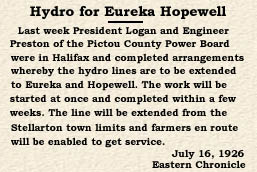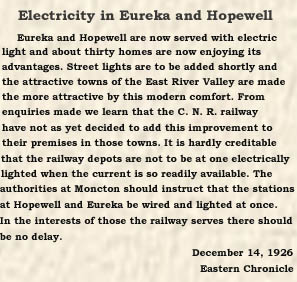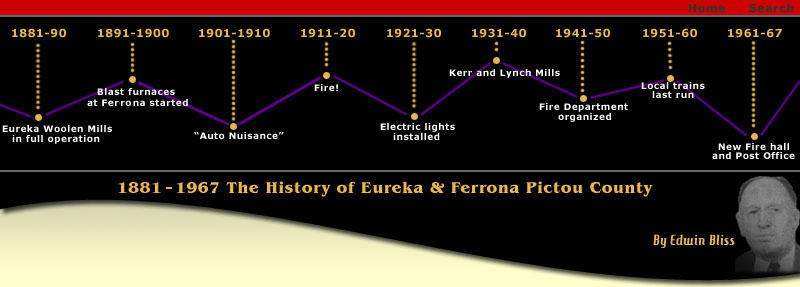1921 - 1930
1921
About the year, 1921, the young people started to become interested
in the game of Tennis, and the use of a lot of land, situated
between the coffin house and the property, now, owned by Mr. and
Mrs. Spurr, but at that time owned by Mr. Samuel Brown, was
acquired. The land was leveled off and posts with wire netting were
put up around the lot. I am not altogether sure whether a Tennis
Club was formally organized at that
time or whether it was just established on a co-operative basis, at
any rate, many pleasant hours were enjoyed there during the next few
years. At least two members of the first Tennis Club, played at this
time; Mr. George Kerr and Mr. Joseph N. Fraser.
1922
For some time previous to the year, 1922, the increasing cost of
fuel, and a somewhat more strained economic situation, made the
people of the village aware that they had in their boundaries a
source of fuel that was theirs for the taking. In 1894, when the
protest was made about the Ferrona Iron Works polluting the East
River, a dam had been erected parallel to the river, where the coal
washings would have a chance to settle before the water filtered
through. This resulted in quite a depth of the coal wash
accumulating, and when this was dug up and mixed with water, it was
found to make quite an efficient fuel. It continued to be used in
ever increasing quantities, and there were few families, if any,
that did not stock up a supply for the winter. Some of it was
trucked away to Hopewell, Foxbrook, Riverton and even more distant
points. The supply lasted for quite a number of years. There were
also pockets of coke that were found and put to good use. Eventually
this legacy from by-gone years was all used up.
1923
On January 7, 1923, the Church Bell, which had been donated as a
gift from Miss Sadie Muir, of the United States, to Zion
Congregation, was dedicated in memory of members of the Muir family.
In Memory of Father, Robert Muir, 1826-1911; Mother, Margaret Keith
Muir, 1832 – 1907; Sister, Margaret Muir Hastings, 1854 – 10-3;
Brother, Sylvanus Keith Muir, 1866 – 1918.
In March, 1923, a Bill was introduced into the Legislature, to
change the “Rule of the Road” of “The Motor Vehicle Act, 1918” up to
this time the Rule of the Road was to keep to the “left” when
passing another vehicle. The Amendment was to make the change to
“Keep to the Right”. It was passed and went into force on April 2,
1923.
On June 16, 1923, George Wood Sinnis married Mrs. Elsie McGrath, of
New Glasgow.
On August 28, 1923, Silas H. Muir, of New Glasgow, married Estella
M. Brown, of Eureka.
1924
Following the first World War it became apparent that cheaper power
was a necessity in Pictou County. This eventually resulted in the
formation of an organization known as the Progressive Club. This
Club then decided to apply to the Legislature for an Act to
incorporate the Pictou County Power Board. The Act was passed and
became law on May 22, 1920. The first meeting of the Board was held
in Stellarton on June 16, 1922. On September 5, 1922, the Officers
of the Board were authorized to sign a contract with the Nova Scotia
Power Commission for the initial development of Malay Falls. The
Pictou County Electric Co., Ltd. which had been started in 1904, was
purchased. Power was turned on from Sheet Harbor in May, 1924.
(April 14, 1924)
On June 19, 1924, a delegation consisting of Mr. Andrew Lynch, J.
Ed. McLean, J. Harlan McLean, Donald Dunbar, Dr. W. A. McLeod, Gray
Fraser, D.M. Grant, George H. McKay and Mr. Campbell from Eureka and
Hopewell, waited upon the Executive of the Pictou County Power Board
and discussed the matter of an electric light supply for these two
villages. It was estimated that there would be 30 household users in
Eureka and 40 in Hopewell. The firm of Kerr and Lynch asked for a 25
H.P. , load for their plant.
1925
In 1925, Church Union took place. The property of Zion Church was
retained by the Presbyterian Congregation. The people of the village
were divided on the question of Church Union, but because of
economic conditions it was agreed that they would all work together
for the common cause. In the village were also a number of families
that had belonged to the Methodist Church. Rev. J. A. Forbes, was
the pastor of Zion Church, from 1923 – 1927, and all the people
continued to worship, quite harmoniously, in the Presbyterian
Church, during this period and for a number of years afterwards when
the Church was mostly supplied by Student Ministers. The various
Church Organizations continued at a fairly even pace, even if they
did not seem to thrive, however there was one exception, the Young
People’s Group started to flourish at this period, and generally
took command of the activity in the Community, this organization was
largely responsible for the organizing and support of a number of
Clubs started in this period, and for the vitality of the village
enjoyed during the years of depression.
1926

 In July, 1926, arrangements were completed in Halifax, by President
Alfred Logan and Engineer Preston, of the Pictou County Power Board,
whereby, the Hydro Lines were to be extended to Eureka and Hopewell. In July, 1926, arrangements were completed in Halifax, by President
Alfred Logan and Engineer Preston, of the Pictou County Power Board,
whereby, the Hydro Lines were to be extended to Eureka and Hopewell.
The villages of Eureka and Hopewell were supplied with electric
light in December, 1926, and the residents were looking ahead to
having Street Lights installed.

During the month of December, two old residents of the village of
Ferrona died: John Robert McLeod, on December 23, 1926, in his 80th
year, and John J. MacKinnon, a native of Ohio, Antigonish County,
aged 72 years.
1927
In 1927, the Young People became dissatisfied with the location of
their Tennis Court, by the coffin house, largely because of the lack
of space, inside the wire netting and also because of the difficulty
of retrieving lost tennis balls from Mr. Brown’s hay field when lost
there. Mr. Brown was totally un-co-operative with the boys on such
occasions, but would inevitably succumb to the charms of the young
ladies when approached. Permission was obtained from the Nova Scotia
Textile Company, at Windsor, through their representative at Eureka,
Mr. George H. McKay, to establish a Tennis Court on the Old Mill
Site. A lot of work was performed by the Young People at this time,
preparing the ground for the Court, digging holes for the posts and
stringing wire netting. The Eureka Tennis Club was organized at this
time and continued extremely active through the most of the 1930’s.
It was a self-supporting organization, with the expenses being met,
by the young ladies holding teas, the presentation of plays during
the winter and spring months, and by the payment of Club fees.
On May 16, 1927, Miss Winnifred Livingston, died at Ferrona
Junction, in the twenty-fifth year of her age. Mrs. Elizabeth
Hingley died on August 5, 1927, aged 87 years. Mr. William Pye died
on September 19, 1927, aged 48 years.
Ross Swinamer, of Ferrona, married Annabella Robertson, of
Churchville, on September 28, 1927. Donald Malcolm Fraser married
Annie Isabel Munro, of Eureka, on September 28, 1927. J. Wallace
McLean married Elizabeth Margaret McDonald, of Lorne, on November 2,
1927.
1928
On February 15, 1928, Mr. James H. Reid, of Eureka, died, aged 78
years. He had worked at the Old Black Diamond Mine, at Westville.
Later he came to Ferrona to work on the Office Staff at the Iron
Works, until they were removed to Sydney. In 1913, he purchased the
business of William Urquhart & Son, which he carried on, until a
year or two before his death. He was a quiet man, retiring, genial;
for years during the Spring months, he could be seen at the break of
day, casting a fishing line into the waters below the Mill Falls. He
was a Member of Zion Church, and of Western Star Lodge, Westville.
A group of Boy Scouts, had been organized in the village of Eureka,
by Rev. A. W. Robertson, in the year 1917, with Mr. Emery as
Scoutmaster. At that time the boys had met and held their meetings,
mostly at the Manse; there, they were instructed in the fundamental
principles of Scouting. This group carried on for a brief period but
was finally discontinued.
In 1928, the Boy Scout Movement was again revived, and organized
under the leadership of Mr. Frederick Falconer, as Scoutmaster. Mr.
Falconer, immediately, took a keen interest in the work of the Boy
Scouts and devoted a large portion of his time to the study of
Scouting, instructing the boys in the art, and generally promoting
the craft, not only in Eureka, but also in the County as well. He
took the boys away on frequent hikes, did much towards the
establishment of Camp Roderick, at Sunny Brae, attended Jamborees on
different occasions. He became a member of the Pictou County Scout
Executive and helped to promote and conduct many Scout Meets. Fred
carried on this work for a great many years until the pressure of
his work and other interests forced him to relinquish it. The people
of Eureka and also the County, owe a debt to Mr. Falconer, perhaps
unknowingly, for his work in this respect. In 1928, Mr. Frederick
William Falconer, also, entered into the sea of matrimony by taking
as his bride, Isabel Cynthia Gillespie, on September, 1928.
On December 24, 1928, Mary Anna Grant, daughter of Mr. and Mrs. D.M.
Grant, of Eureka, was married at Calgary, Alberta, to Mr. Lawrence
Sinclair Nicholson, of Edmonton, Alberta, and formerly of Edinburgh,
Scotland.
1929
The year, 1929, was a comparatively prosperous one for the village
of Eureka, many of the men were employed at the Eastern Car Plant,
which had a busy year, requiring the employment of a night shift
during the summer months. The first half of the year, saw a number
of the pioneers of the village pass away. Early in January, 1929,
Mr. Kenneth McMillan, who had been the Station Agent, at Eureka, for
many years, died. On January 26, 1929, Mrs. James Kerr passed away,
and she was closely followed by her husband, James Oliver Kerr, On
April 26, 1929. Mr. J. Preston McLean died on June 17, 1929, he was
not a pioneer of the village.
1930
Up to this point, the History of Eureka, has been written
chronologically, with some reference made to happenings in each
year. Possibly I could continue as I have been doing, but as it
would be largely the history of village organizations and
individuals, it would run into much repetition, because of which I
will only make reference to events that generally affect the
village. Before proceeding I will refer back to a few matters that I
inadvertently missed as I passed along. The Swinging Bridge,
crossing over the East Branch of the East River, was erected when
the Iron Works were in operation, and gave many a thrill to persons
passing over it for the first time, it is still kept in repair and
used as a foot bridge. For many years previous to 1930, and for a
few years afterwards, a number of the residents of the village kept
cows for their convenience and for the supplying of milk. Many of
these cows were driven, during the summer months, to Grant’s
pasture, a large area leased from the Nova Scotia Steel Company, by
Mr. D.M. Grant. The cows passed over the main road to the pasture in
the mornings and returned by the same route in the evenings, the
result was that pedestrians had to carefully pick their footsteps by
daylight, and involuntary imprecations were often rendered from them
at night.
The outburst that had taken place against motor vehicles, from 1907
to 1912, had gradually subsided. Cars had become more numerous and
the diminishing ranks of the horses used on the roads had become
totally unconcerned about the motor vehicles. In Eureka, a garage
had been opened up and was operated by Mr. Fraser MacDonald, caring
for and servicing the wants of the driving public. Up to this time
and for sometime afterwards the roads were not plowed in the winter.
If they were opened up for car travel it was accomplished by
manpower or as on a few occasions by a local subscription assisted
by the town merchants, by which a snowplow was hired to do the job.
The year, 1930, was the start of the depression years. Work and
money were scarce and idleness was the general vogue, but somehow
the organizations, already mentioned in Eureka seemed to prosper,
The Young People’s Society, the Tennis Club and the Boy Scouts, and
to these were added during the 1930’s, the Softball Club, which
joined in a County Rural League, the operating and traveling
expenses of this Club was often run on a shoestring, and sometimes
only by the voluntary support of the fans in the village who owned
cars. The playing of games drew large crowds throughout the County.
A Rink was also established in the village on two different
locations, first, in the field, or swamp, to the south of the Eureka
Station, and next on the Tennis Court on the Old Mill Site. This
contributed much to winter leisure and enjoyment. Many amateur plays
were presented by the Young People during this period, both locally,
and in various other places, and these always drew full houses. When
a sum of money was needed in a hurry, the young ladies were always
ready to co-operate by holding a tea or supper, to raise the
necessary amount. Many successful dances were also held in Muir’s
Hall, all of these projects were well patronized by the general
public.
1931-1940

|

